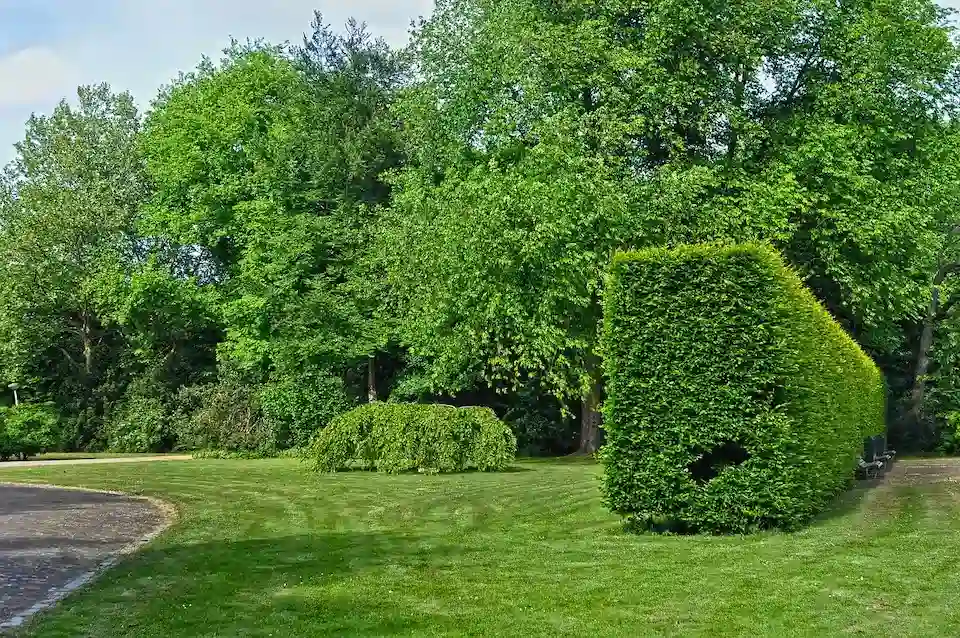A well-maintained outdoor space can do wonders for the curb appeal of your home. Hedges not only enhance your property’s aesthetic appeal but also provide local wildlife privacy, security, and shelter. However, knowing when and how to trim your hedges can be a bit tricky, especially in North Carolina’s diverse climate.

That’s why our Wake Forest landscaping experts are sharing everything you need to know about when to trim hedges in North Carolina to help local homeowners keep their hedges in top shape.
What Types of Hedges are Best for NC Landscapes?
When it comes to choosing the right hedge for your North Carolina landscape, it’s essential to select species that thrive in the state’s diverse climate. Fortunately, North Carolina offers a wide variety of hedge plants suitable for different regions and preferences.
Boxwood
Boxwoods are evergreen and are known for their versatility, making them a popular choice for hedges in North Carolina. They come in various varieties, each with unique characteristics. Boxwoods are known for their dense, compact growth, making them ideal for formal hedges and topiaries.
They have small, oval-shaped leaves and can be pruned into various shapes. Boxwoods require regular pruning to maintain their shape and size, and they prefer well-drained soil and partial shade.
Leyland Cypress
These fast-growing conifers are excellent for creating privacy screens, property line dividers, and windbreaks. Leyland cypress is commonly found in the coastal regions of the state, and are renowned for their fast-growing, fine, feathery foliage.
They are often chosen for their ability to create dense privacy screens, but they require regular maintenance to control their growth. Leyland Cypress grows rapidly and needs frequent pruning to prevent it from becoming too tall or wide. They thrive in full sun and well-drained soil.
Nellie R. Stevens Holly
These hollies are valued for their glossy, dark green foliage and their ability to withstand heat and drought. They’re often chosen for their year-round interest. This holly variety has glossy, dark green leaves and produces red berries in the winter.
It’s a fast-growing hedge option that provides year-round interest. Additionally, Nellie R. Stevens Holly grow vigorously and benefit from regular pruning to maintain their shape. Tolerating a range of soil types, they prefer well-drained soil most.
American Holly
Another holly variety, American Holly, is known for its flowering hedges of red berries and spiky, evergreen leaves. It’s a native species that can thrive in various North Carolina climates. American Holly is a native species with spiky, dark green leaves and bright red berries. It’s often chosen for its aesthetic appeal and wildlife value.
American Holly is relatively slow-growing and can be shaped through pruning. They prefer well-drained soil and can tolerate partial shade.
Japanese Yew
Japanese Yews are evergreen shrubs with dense foliage, making them suitable for formal hedges. They can tolerate shade and are well-suited for more wooded areas. Japanese Yews have dark green, needle-like leaves and produce red berries. They can be pruned into various shapes and are suitable for both formal and informal hedges.
Japanese Yews are adaptable and can thrive in various soil types and light conditions. They respond well to regular pruning for shape and size control.

Benefits of Regular Hedge Trimming
Hedges are not just a decorative element in your landscape; they serve several practical purposes as well. Regular hedge trimming offers a multitude of benefits, from improving the aesthetic appeal of your property to enhancing its overall value. Here’s a closer look at these advantages.
Aesthetic Appeal
One of the most obvious benefits of regularly trimming and shrub pruning is the immediate boost in aesthetic appeal. Well-maintained hedges contribute to a polished and attractive landscape. By keeping tall hedges neatly pruned and in shape, you can create a visually pleasing boundary for your property.
Whether you have a formal garden with precisely trimmed boxwood hedges or a more natural, informal landscape, proper hedge care for green and flowering shrubs ensures that your outdoor space looks well-groomed and inviting year-round.
Promoting Healthy Growth
Regular trimming of broken branches or overflowing hedges isn’t just about appearances; it’s also essential for the overall health of your hedge plants. Using pruning tools on your shrubs encourages new growth, which can result in denser, bushier hedges.
Removing dead or diseased branches through trimming helps prevent the spread of pests and diseases, allowing your hedges to thrive. Adequate airflow and sunlight penetration are also facilitated by pruning, reducing the risk of fungal infections and promoting robust, vibrant foliage.
Enhancing Property Value
A well-manicured landscape significantly enhances the value of your property. Potential buyers and passersby are often drawn to homes with neatly trimmed hedges, as they reflect care and attention to detail.
Moreover, a carefully landscaped property can command a higher resale value in the real estate market. By investing in regular hedge trimming, you not only enjoy the immediate benefits of an appealing outdoor space but also contribute to the long-term value of your property.
Providing Privacy and Security
Hedges serve as natural barriers, offering privacy and security to your property. Overgrown or neglected hedges may become less effective in fulfilling this role. Regular trimming helps maintain the height and density of your hedges, ensuring they continue to provide a sense of seclusion and security.
Whether you’re enjoying a peaceful moment in your garden or seeking to deter unwanted visitors, well-trimmed hedges act as a reliable natural fence.
Timing Your Hedge Trimming by Season
Proper timing is crucial when it comes to trimming your hedges in North Carolina. Different seasons offer unique advantages and challenges, depending on your specific hedge species and climate zone. Understanding when to trim is essential for maintaining the health and appearance of your hedges. Let’s explore the optimal timing for hedge trimming throughout the year.
Spring Hedge Trimming
With the arrival of warmer weather, typically in late March to early April, it’s the perfect time to assess and trim your hedges. Before you start, ensure you have the necessary pruning tools and safety equipment, including a sharp, electric hedge trimmer and protective gear.
Evaluate the condition of your hedges, identifying any dead or diseased lower branches and irregular growth patterns. Then, proceed with top and side trimming, creating a level, uniform height and a neat, symmetrical shape.
Regular maintenance and proper care will ensure your North Carolina hedges thrive throughout the growing season, enhancing the charm of your garden.
Summer Hedge Trimming
In North Carolina, summer hedge trimming is another essential garden maintenance task that helps keep your outdoor space looking its best during the warm and humid months. Typically, summer trimming should be done in June or July, after the spring growth surge has settled.
Start by assessing your hedges for any overgrowth, unruly branches, or dead foliage that may have developed during the spring and early summer. Trim back excessive growth to maintain the desired shape and size of your hedges. However, avoid heavy pruning during the hottest part of the summer to prevent stress on the plants. Instead, focus on light maintenance and shaping.
Regular watering and mulching your garden and landscape will also help your hedges stay healthy and vibrant during the North Carolina summer heat. By incorporating summer hedge trimming into your garden care routine, you’ll ensure that your hedges continue to enhance your outdoor space throughout the season.
Fall Hedge Trimming
Timing is key, and the best time for fall trimming is typically in early to mid-fall, around September to early October, before the first frost sets in. Begin by assessing your hedges for any late summer growth and unruly branches. Trim back any excessive growth and maintain the desired shape and size of your hedges. This is also an excellent opportunity to remove any dead or diseased branches that may have become more noticeable as the growing season comes to a close.
Fall trimming should focus on maintaining the health and appearance of your hedges rather than heavy pruning. After trimming, consider applying a layer of mulch to insulate the roots and protect them from winter cold. Proper fall hedge trimming in North Carolina ensures that your hedges remain in good condition and are well-prepared for the colder months ahead.
Winter Hedge Trimming
In North Carolina, winter hedge trimming is generally not recommended, as it is best to avoid major pruning during the coldest months. Winter is a time when many plants, including hedges, are in a state of dormancy. Pruning during this period can leave them vulnerable to winter damage, frost, and disease.
However, if you have specific maintenance needs or safety concerns, you can perform some light and selective pruning during late winter, typically in late February or early March, before the new growth begins. Focus on removing any dead, damaged, or diseased branches and tidying up the overall appearance. Be cautious not to over-prune, as this can stress the plants when they are not actively growing.
It’s crucial to prioritize the health and vitality of your hedges during the winter months in North Carolina. Keep an eye on them for any issues that may arise, and save more extensive pruning and maintenance tasks for the spring or early fall when the plants are in a more active growth phase.
Signs Your Hedges Need Trimming
Regular hedge trimming is essential for maintaining their health and appearance. However, it’s equally crucial to recognize when your hedges require attention. Here are some signs to watch for.
Overgrown Appearance
One of the most apparent signs that your hedges need trimming is an overgrown and unruly appearance. When your hedges become too tall or wide for their designated space, they can block sunlight, hinder airflow, and overshadow other plants in your landscape. Overgrown hedges not only look untidy but can also become a maintenance challenge.
Loss of Shape and Definition
Hedges are often planted to create defined borders or shapes within your landscape. When they start to lose their shape and definition, it can detract from the overall aesthetic of your property. Pruning hedges regularly helps maintain their intended form, whether it’s a neat rectangle, a rounded curve, or another desired shape.
Yellowing or Browning Leaves
Yellowing or browning leaves on your hedges can be indicative of several issues, including nutrient deficiencies, water stress, or lawn diseases. Trimming can help identify and address these problems. Removing dead or diseased branches not only improves the hedge’s appearance but also promotes healthier new growth.
Pests or Diseases
Hedges that are infested with pests or affected by diseases can quickly deteriorate if not addressed promptly. Signs of pest infestations can include discolored or damaged foliage, visible insects, or webbing. Diseases may manifest as spots, lesions, or unusual growth patterns. Regular inspection and timely trimming can help detect and manage these issues before they spread to the entire hedge or to nearby plants.
Contact Our Hedge Trimming Experts in Wake Forest Today
Are your hedges in need of professional care and attention? Don’t wait until they become overgrown, lose their shape, or suffer from pest and disease issues. Our team of experienced hedge-trimming experts at FortSmith Landscaping in Wake Forest, NC, is here to help you transform your outdoor space into a lush, well-maintained oasis.
Contact us today to schedule a consultation with our skilled landscaping professionals in Wake County by calling us at (919) 228-8495 or filling out the form to the right to get started.
